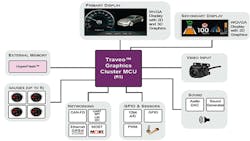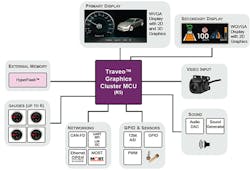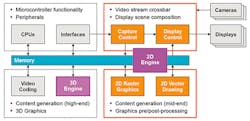Micro Targets Telematics With 3D And HyperBus Support
Spansion’s Traveo (Fig. 1) mixes 400 DMIPS ARM Cortex-R5 core with 3D graphics and Spansion’s HyperBus (see “How HyperBus Delivers 330 Mbyte/s Using A Dozen Signals”) to target automotive telematics applications. The single chip solution addresses the range of telematics chores including support for a rear-view camera, multiple displays and networking.
The Traveo family can handle CAN-FD, MOST and Ethernet AVB (audio video bridging). It can handle display interfaces like LVDS and RSDS. The system also provides high-end audio support. A 12-bit ADC and GPIO provide additional peripheral functionality.
The graphics engine (Fig. 2) handles 2D and 3D chores including camera input. The hardware surface image generation allows 3D presentation without the need for a costly frame buffer. The system also has Bezier curve and fill functions in hardware to support smother text display. The HyperBus interface provides access to off-chip flash and RAM providing access to more graphic content.
The HyperBus matches the low cost target for the Traveo. HyperBus utilizes fewer interface pins allowing the use of lower cost flash and RAM storage. HyperBus can deliver 330 Mbytes/s compared to under 100 Mbytes/s for QSPI, the other low pin-count memory option.
Traveo also incorporates Spansion’s Secure Hardware Extensions (SHE). This includes secure boot, AES support, message authentication code (MAC) support and a random number generator (RNG).
About the Author
William G. Wong
Senior Content Director - Electronic Design and Microwaves & RF
I am Editor of Electronic Design focusing on embedded, software, and systems. As Senior Content Director, I also manage Microwaves & RF and I work with a great team of editors to provide engineers, programmers, developers and technical managers with interesting and useful articles and videos on a regular basis. Check out our free newsletters to see the latest content.
You can send press releases for new products for possible coverage on the website. I am also interested in receiving contributed articles for publishing on our website. Use our template and send to me along with a signed release form.
Check out my blog, AltEmbedded on Electronic Design, as well as his latest articles on this site that are listed below.
You can visit my social media via these links:
- AltEmbedded on Electronic Design
- Bill Wong on Facebook
- @AltEmbedded on Twitter
- Bill Wong on LinkedIn
I earned a Bachelor of Electrical Engineering at the Georgia Institute of Technology and a Masters in Computer Science from Rutgers University. I still do a bit of programming using everything from C and C++ to Rust and Ada/SPARK. I do a bit of PHP programming for Drupal websites. I have posted a few Drupal modules.
I still get a hand on software and electronic hardware. Some of this can be found on our Kit Close-Up video series. You can also see me on many of our TechXchange Talk videos. I am interested in a range of projects from robotics to artificial intelligence.



